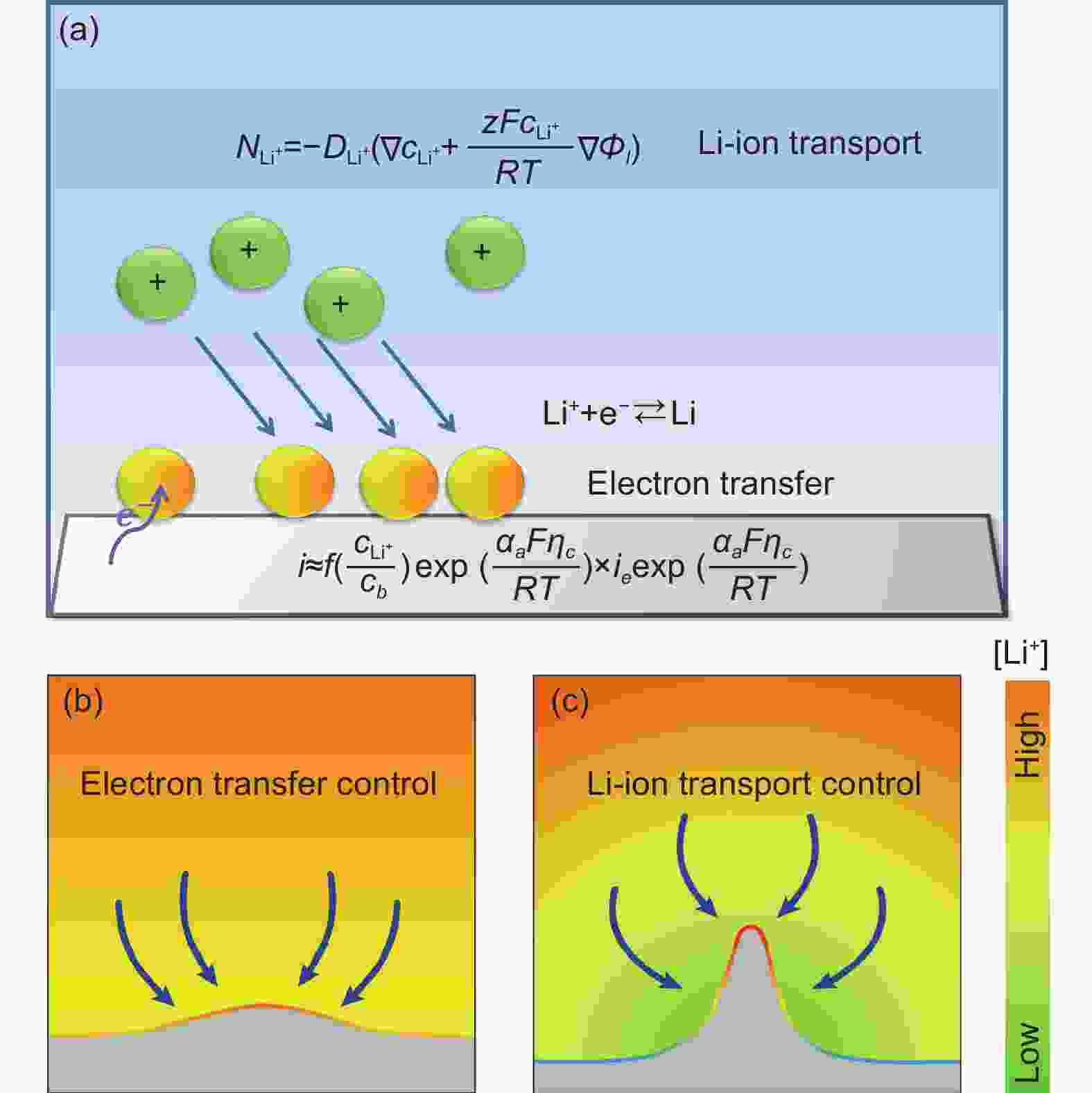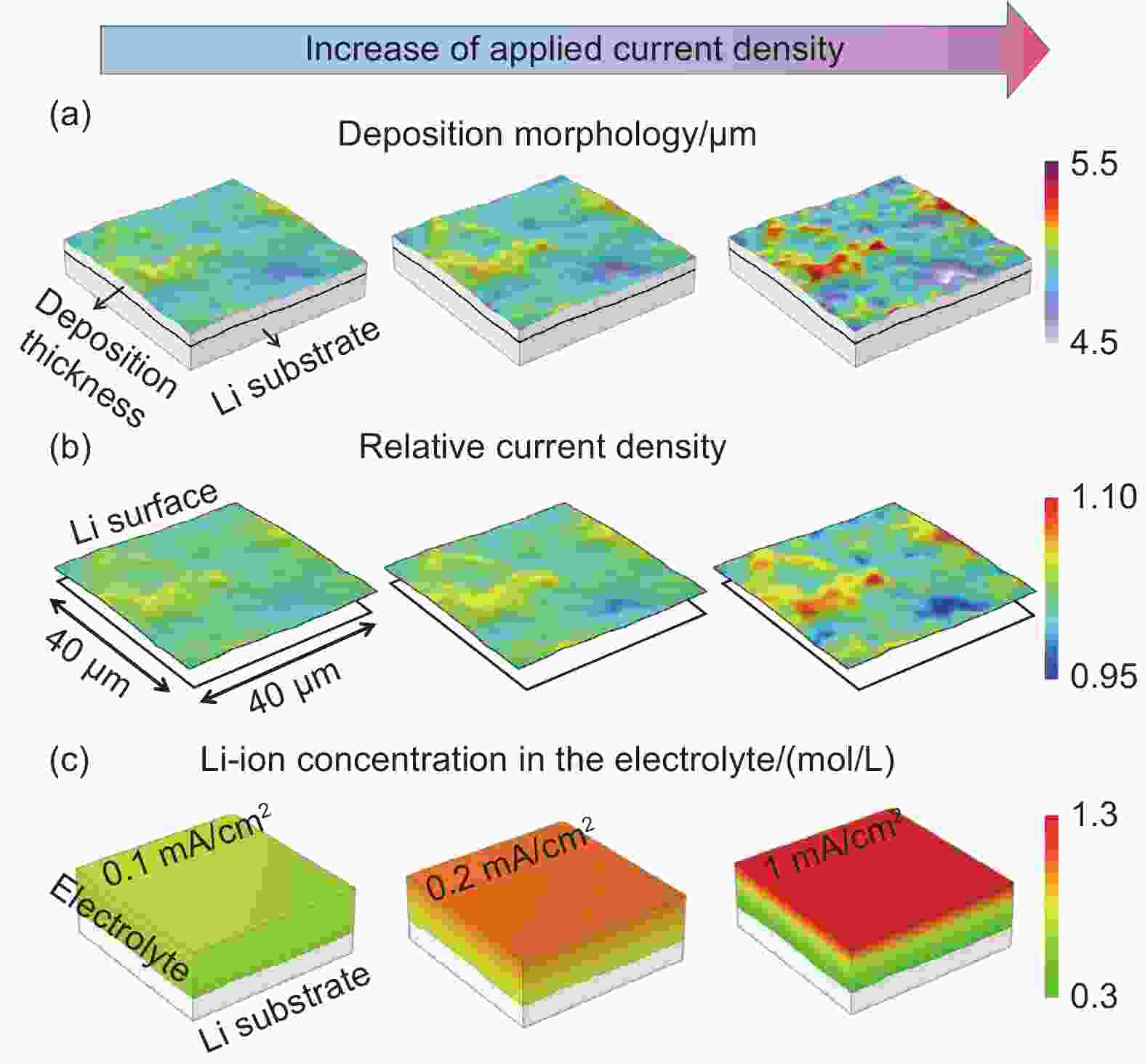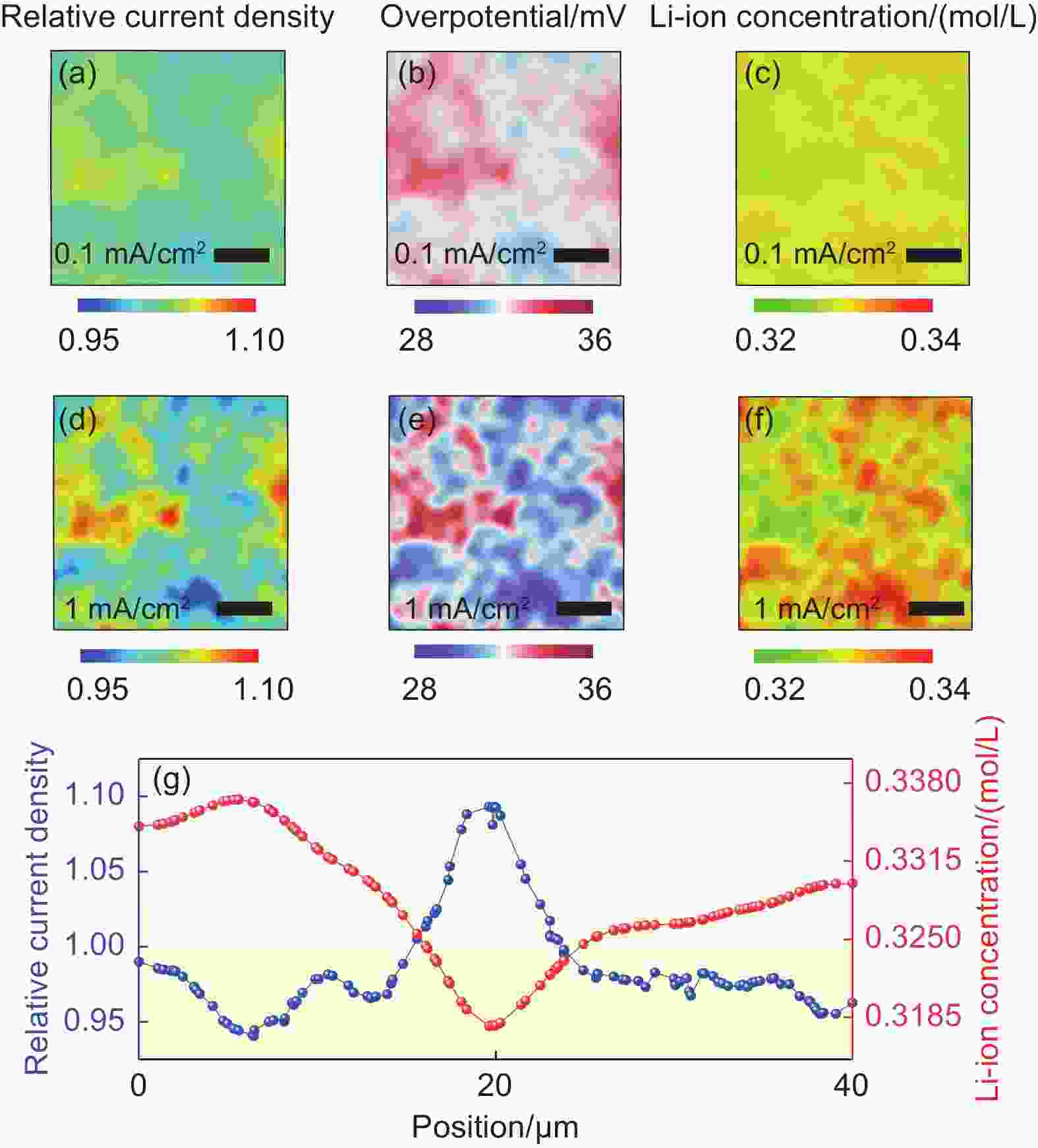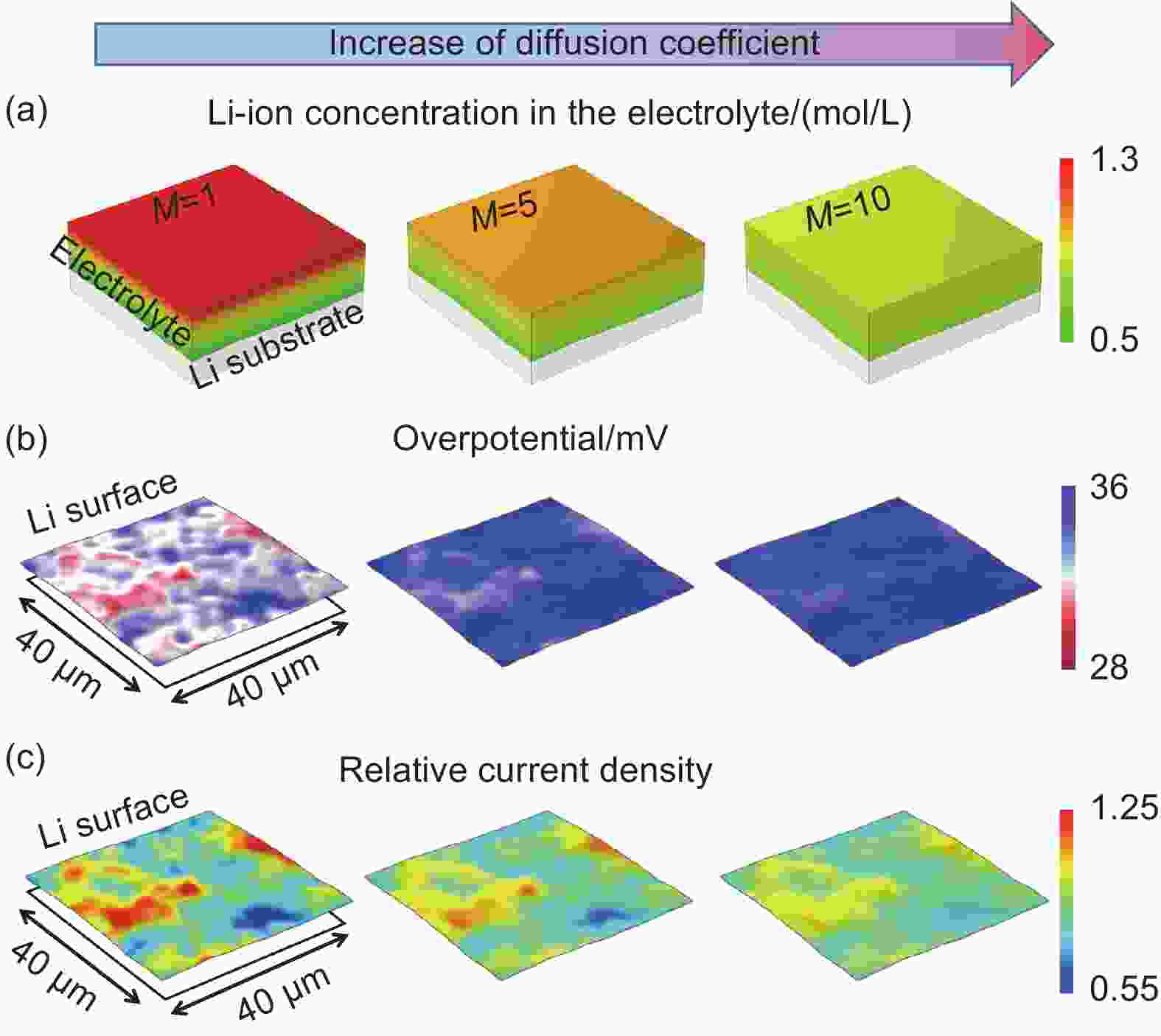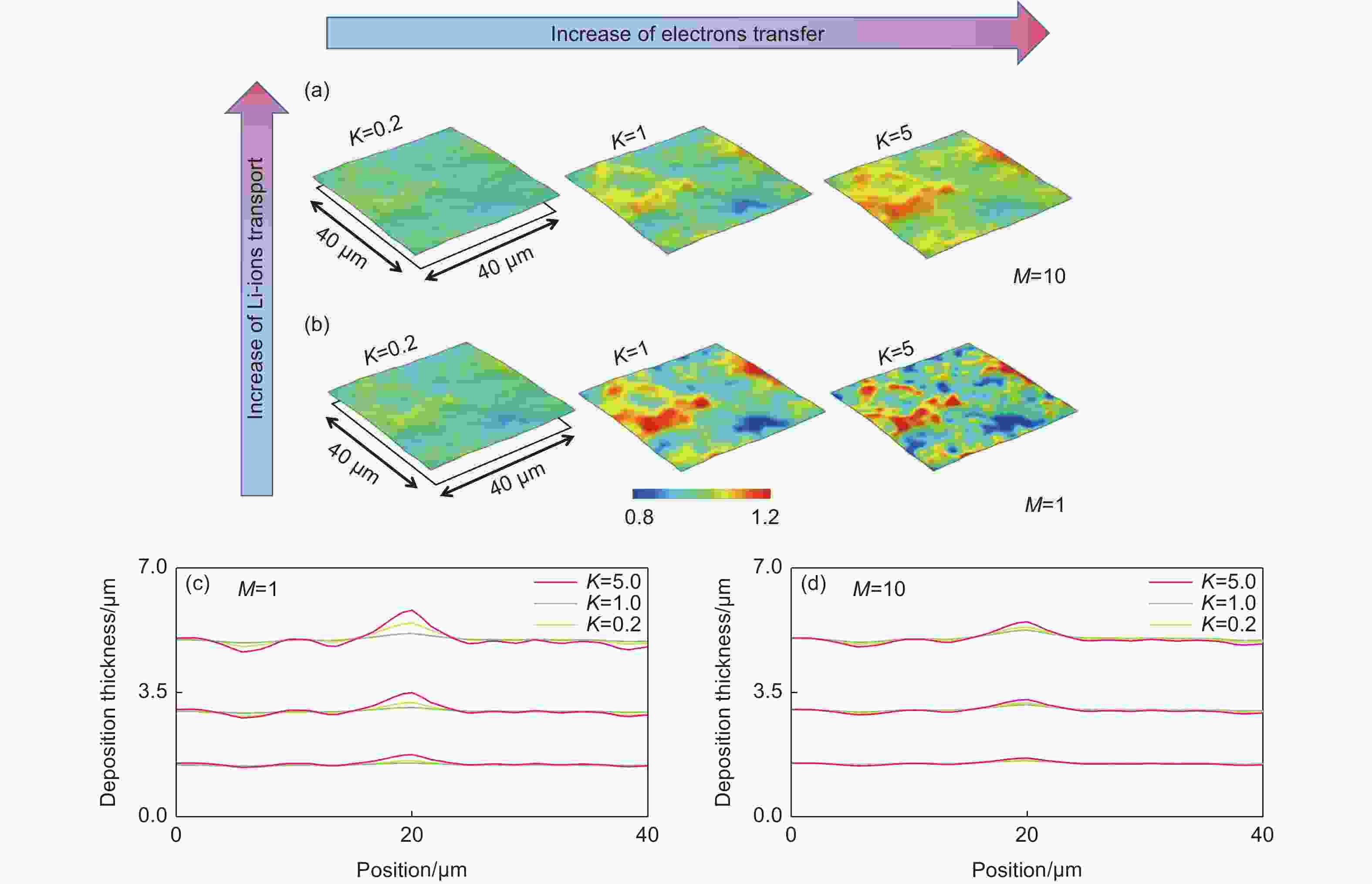The factors that influence the electrochemical behavior of lithium metal anodes: electron transfer and Li-ion transport
-
摘要: 锂金属负极被认为是下一代储能电池中最有应用前景的负极材料。然而,严重的且无法避免的锂枝晶生长和潜在的安全隐患阻碍了其实际应用的发展。结构化碳基集流体负极结构能改善锂离子的输运,还能减缓电子转移的速度,同时已被证明能有效地抑制锂枝晶生长,但仍需更深入地理解基本的电化学原理来研究电荷转移和离子输运的协同作用。本文模拟并量化了控制锂离子电化学行为的两个关键过程,即电子转移和锂离子输运因素。通过有限元法可视化了三维电池模型(锂//电解液//锂)中的局部沉积速率,过电位以及锂离子浓度,揭示了锂离子输运速度和电子转移之间的竞争关系。当电子转移相对较慢时,负极表面附近有足够的锂离子可以发生反应,锂负极的沉积行为则由电子转移控制。然而,在锂离子的输运速率低于电子转移速率的情况下,负极表面的锂离子将会持续消耗,出现锂离子耗尽的情况,锂离子输运将主导锂负极的沉积过程,最终导致锂枝晶形貌。因此,在快充条件下和实际应用中,降低锂负极的反应活性和加速锂离子输运是获得锂金属负极均匀沉积形貌的关键。Abstract: Structured carbon-based hosts for the Li anode both improve the transport of Li-ions and reduce the electron transfer rate and have proven to be an effective way to suppress dendrite growth in lithium metal anodes. An in-depth understanding of these effects is needed to clarify the intrinsic electrochemical mechanism involved. We used the finite element method to simulate the two crucial processes controlling Li-ion behavior, electron transfer and Li-ion transport, and visualized the local deposition rate, the overpotential, and the Li-ion concentration in a three-dimensional (3D) Li//electrolyte//Li cell. Our analysis showed a competitive relationship between the rates of Li-ion transport and electron transfer. When the electron transfer rate is relatively slow, there are sufficient Li-ions available near the anode surface and the deposition behavior is controlled by electron transfer. However, when the number of Li-ions is low, Li-ion transport dominates the deposition process because it is unable to keep up with electron transfer, and this causes dendrite formation. Therefore, reducing the reactivity of the Li anode and accelerating Li-ion transport are the two key factors to produce uniform Li metal deposition on the anode, particularly under fast charging conditions and in practical use.
-
Key words:
- Lithium metal anodes /
- Finite element method /
- Electron transfer /
- Li-ion transport
-
Figure 1. (a) Schematic showing the Li-ion transport and electron transfer process with their corresponding controlling equations upon charging. The Li metal anode morphology under (b) electron transfer control with sufficient Li-ions and (c) Li-ion transport control with large Li-ion concentration gradient, the background color represents the concentration of Li-ions and the lines at the electrolyte-electrode interface show the local current densities
Figure 2. Under different applied current densities of 0.1 mA/cm2 , 0.2 mA/cm2 and 1 mA/cm2 but with the same capacity (1 mAh/cm2), the simulation results for (a) the deposition morphology of Li substrate, (b) the relative current density (iloc/ iapp) distribution at anode surface, and (c) Li-ion concentration distribution in the electrolyte
Figure 3. The relative current density distribution at the anode surface under the iapp of (a) 0.1 mA/cm2 and (d) 1 mA/cm2 with the same capacity (1 mAh/cm2), the overpotential distribution under the iapp of (b) 0.1 mA/cm2 and (e) 1 mA/cm2 as well as Li-ion concentration distribution under the iapp of (c) 0.1 mA/cm2 and (f) 1 mA/cm2. The scale bar in is10 μm. (g) Comparation for the distribution of relative current density and Li-ion concentration curves along the line at anode surface at the iapp of 1 mA/cm2
Figure 4. Li-ion electrochemical behaviors under different
$ {D}_{{Li}^{+}} $ gradients of 1 time, 5 times and 10 times ($ {D}_{{Li}^{+}}=M\times {D}_{{Li}^{+}}^{0} $ , M = 1, 5, 10) with the iapp of 1 mAh/cm2. (a) Li-ion concentration distribution in the electrolyte. (b) Overpotential and (c) Relative current density distribution near the anode surfaceFigure 5. Li-ion concentration distribution in the electrolyte under different electron transfer rate from 0.2 times to 5 times (
$ {i}_{e}=K\times{i}_{\mathrm{e}}^{0} $ , K = 0.2, 1, 5) matched with (a) high Li-ion coefficient (M = 10) and (b) low Li-ion coefficient (M = 1). (c) Distribution of Li-ion deposition morphology along the selected curve under different combinations of electron transfer rate and Li-ion coefficient -
[1] Liu J, Bao Z, Cui Y, et al. Pathways for practical high-energy long-cycling lithium metal batteries[J]. Nature Energy,2019,4(3):180-186. doi: 10.1038/s41560-019-0338-x [2] Cheng X B, Zhang R, Zhao C Z, et al. Toward safe lithium metal anode in rechargeable batteries: A review[J]. Chemical Reviews,2017,117(15):10403-10473. doi: 10.1021/acs.chemrev.7b00115 [3] Lin D, Liu Y, Cui Y. Reviving the lithium metal anode for high-energy batteries[J]. Nature Nanotechnology,2017,12(3):194-206. doi: 10.1038/nnano.2017.16 [4] Tarascon J M, Armand M. Issues and challenges facing rechargeable lithium batteries[J]. Nature,2001,414(6861):359-367. doi: 10.1038/35104644 [5] Zhou G, Chen H, Cui Y. Formulating energy density for designing practical lithium–sulfur batteries[J]. Nature Energy,2022,7(4):312-319. doi: 10.1038/s41560-022-01001-0 [6] Bruce P G, Freunberger S A, Hardwick L J, et al. Li–O2 and Li–S batteries with high energy storage[J]. Nature Materials,2012,11(1):19-29. doi: 10.1038/nmat3191 [7] Albertus P, Babinec S, Litzelman S, et al. Status and challenges in enabling the lithium metal electrode for high-energy and low-cost rechargeable batteries[J]. Nature Energy,2018,3(1):16-21. [8] Xu X Q, Cheng X B, Jiang F N, et al. Dendrite-accelerated thermal runaway mechanisms of lithium metal pouch batteries[J]. SusMat,2022,2(4):435-444. doi: 10.1002/sus2.74 [9] Chen S, Niu C, Lee H, et al. Critical parameters for evaluating coin cells and pouch cells of rechargeable li-metal batteries[J]. Joule,2019,3(4):1094-1105. doi: 10.1016/j.joule.2019.02.004 [10] Ni S, Sheng J, Zhang C, et al. Dendrite-free lithium deposition and stripping regulated by aligned microchannels for stable lithium metal batteries[J]. Advanced Functional Materials,2022,32(21):2200682. doi: 10.1002/adfm.202200682 [11] Ni S, Zhang M, Li C, et al. A 3D framework with Li3N–Li2S solid electrolyte interphase and fast ion transfer channels for a stabilized lithium-metal anode[J]. Advanced Materials,2023,35(8):2209028. doi: 10.1002/adma.202209028 [12] Piao Z, Gao R, Liu Y, et al. A review on regulating Li+ solvation structures in carbonate electrolytes for lithium metal batteries[J]. Advanced Materials,2023,35(15):2206009. [13] Piao Z, Ren H R, Lu G, et al. Stable operation of lithium metal batteries with aggressive cathode chemistries at 4.9 V[J]. Angewandte Chemie International Edition,2023,62(15):e202300966. doi: 10.1002/anie.202300966 [14] Park S, Jeong S Y, Lee T K, et al. Replacing conventional battery electrolyte additives with dioxolone derivatives for high-energy-density lithium-ion batteries[J]. Nature Communications,2021,12(1):838. doi: 10.1038/s41467-021-21106-6 [15] Sun C, Sheng J, Zhang Q, et al. Self-extinguishing janus separator with high safety for flexible lithium-sulfur batteries[J]. Science China Materials,2022,65(8):2169-2178. doi: 10.1007/s40843-022-2034-5 [16] Sheng J, Zhang Q, Liu M, et al. Stabilized solid electrolyte interphase induced by ultrathin boron nitride membranes for safe lithium metal batteries[J]. Nano Letters,2021,21(19):8447-8454. doi: 10.1021/acs.nanolett.1c03106 [17] Luo D, Zheng L, Zhang Z, et al. Constructing multifunctional solid electrolyte interface via in-situ polymerization for dendrite-free and low N/P ratio lithium metal batteries[J]. Nature Communications,2021,12(1):186. doi: 10.1038/s41467-020-20339-1 [18] Guo W, Han Q, Jiao J, et al. In situ construction of robust biphasic surface layers on lithium metal for lithium–sulfide batteries with long cycle life[J]. Angewandte Chemie International Edition,2021,60(13):7267-7274. doi: 10.1002/anie.202015049 [19] Wang Y, Liu F, Fan G, et al. Electroless formation of a fluorinated Li/Na hybrid interphase for robust lithium anodes[J]. Journal of the American Chemical Society,2021,143(7):2829-2837. doi: 10.1021/jacs.0c12051 [20] Thanner K, Varzi A, Buchholz D, et al. Artificial solid electrolyte interphases for lithium metal electrodes by wet processing: The role of metal salt concentration and solvent choice[J]. ACS Applied Materials & Interfaces,2020,12(29):32851-32862. [21] Kim S, Park S O, Lee M Y, et al. Stable electrode–electrolyte interfaces constructed by fluorine- and nitrogen-donating ionic additives for high-performance lithium metal batteries[J]. Energy Storage Materials,2022,45:1-13. doi: 10.1016/j.ensm.2021.10.031 [22] Raccichini R, Varzi A, Passerini S, et al. The role of graphene for electrochemical energy storage[J]. Nature Materials,2015,14(3):271-279. doi: 10.1038/nmat4170 [23] Chen M, Zheng J, Sheng O, et al. Sulfur–nitrogen Co-doped porous carbon nanosheets to control lithium growth for a stable lithium metal anode[J]. Journal of Materials Chemistry A,2019,7(31):18267-18274. doi: 10.1039/C9TA05684J [24] Tang L, Zhang R, Zhang X, et al. ZnO nanoconfined 3D porous carbon composite microspheres to stabilize lithium nucleation/growth for high-performance lithium metal anodes[J]. Journal of Materials Chemistry A,2019,7(33):19442-19452. doi: 10.1039/C9TA06401J [25] Doyle M, Fuller T F, Newman J. Modeling of galvanostatic charge and discharge of the lithium/polymer/insertion cell[J]. Journal of The Electrochemical Society,1993,140(6):1526. doi: 10.1149/1.2221597 [26] Kemper P, Li S E, Kum D. Simplification of pseudo two dimensional battery model using dynamic profile of lithium concentration[J]. Journal of Power Sources,2015,286:510-525. doi: 10.1016/j.jpowsour.2015.03.134 [27] Xu X, Liu Y, Hwang J Y, et al. Role of Li-ion depletion on electrode surface: Underlying mechanism for electrodeposition behavior of lithium metal anode[J]. Advanced Energy Materials,2020,10(44):2002390. doi: 10.1002/aenm.202002390 [28] Liu Y, Xu X, Sadd M, et al. Insight into the critical role of exchange current density on electrodeposition behavior of lithium metal[J]. Advanced Science,2021,8(5):2003301. doi: 10.1002/advs.202003301 [29] Chen L, Zhang H W, Liang L Y, et al. Modulation of dendritic patterns during electrodeposition: A nonlinear phase-field model[J]. Journal of Power Sources,2015,300:376-385. doi: 10.1016/j.jpowsour.2015.09.055 [30] Zhang R, Shen X, Cheng X B, et al. The dendrite growth in 3D structured lithium metal anodes: Electron or ion transfer limitation?[J]. Energy Storage Materials,2019,23:556-565. doi: 10.1016/j.ensm.2019.03.029 [31] Biswal P, Stalin S, Kludze A, et al. Nucleation and early stage growth of li electrodeposits[J]. Nano Letters,2019,19(11):8191-8200. doi: 10.1021/acs.nanolett.9b03548 [32] Xu X, Jiao X, Kapitanova O O, et al. Diffusion limited current density: A watershed in electrodeposition of lithium metal anode[J]. Advanced Energy Materials,2022,12(19):2200244. doi: 10.1002/aenm.202200244 [33] Yoon G, Moon S, Ceder G, et al. Deposition and stripping behavior of lithium metal in electrochemical system: Continuum mechanics study[J]. Chemistry of Materials,2018,30(19):6769-6776. doi: 10.1021/acs.chemmater.8b02623 [34] Jana A, Woo S I, Vikrant K S N, et al. Electrochemomechanics of lithium dendrite growth[J]. Energy & Environmental Science,2019,12(12):3595-3607. [35] Allen J, Bard, Larry R Faulkner. Electrochemical methods: Fundamentals and applications, new york: Wiley, 2001, 2nd ed[J]. Russian Journal of Electrochemistry,2002,38(12):1364-1365. doi: 10.1023/A:1021637209564 [36] Nørskov J K, Bligaard T, Logadottir A, et al. Trends in the exchange current for hydrogen evolution[J]. Journal of The Electrochemical Society,2005,152(3):J23. doi: 10.1149/1.1856988 [37] Wang Y, Wang J, Zhao X, et al. Reducing the charge overpotential of Li –O2 batteries through band-alignment cathode design[J]. Energy & Environmental Science,2020,13(8):2540-2548. [38] Stuve E M. Overpotentials in Electrochemical Cells [M]. Encyclopedia of applied electrochemistry. New York; Springer New York. 2014: 1445-1453. [39] Bai P, Li J, Brushett F R, et al. Transition of lithium growth mechanisms in liquid electrolytes[J]. Energy & Environmental Science,2016,9(10):3221-3229. [40] Henry J S S. On the concentration at the electrodes in a solution, with special reference to the liberation of hydrogen by electrolysis of a mixture of copper sulphate and sulphuric acid[J]. Proceedings of the Physical Society of London,1899,17(1):496. doi: 10.1088/1478-7814/17/1/332 -





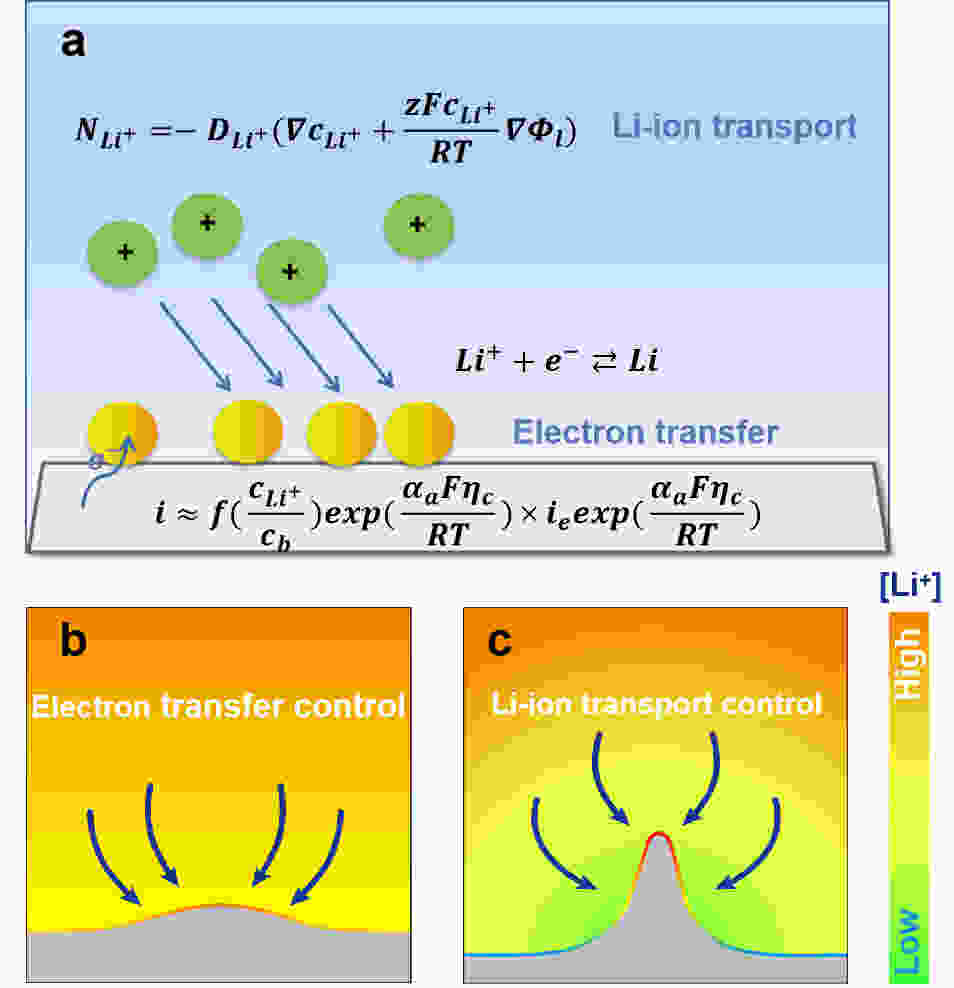
 下载:
下载:
